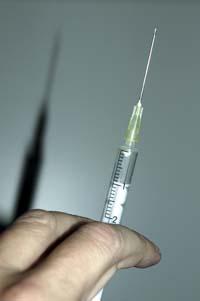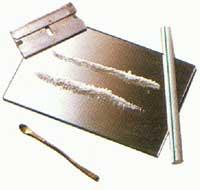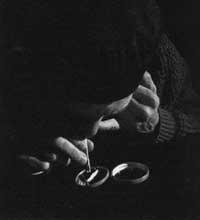Helping to get rid of drugs
2010/11/01 Lakar Iraizoz, Oihane - Elhuyar Zientzia Iturria: Elhuyar aldizkaria

In general, all abusive drugs cause a sense of well-being. "Cocaine, heroin, amphetamines, alcohol, etc. increase the concentration of dopamine in the brain," says Koldo Callado, professor of pharmacology at the University of the Basque Country. This occurs in the area where rewards are processed in the brain. In this way, as the main neurotransmitter is dopamine, increasing the concentration of dopamine greatly excites this region and the consumer has more sense of well-being than normal.
In the study of the journal Nature Medicine, researchers from the biopharmaceutical company Gilead Sciences have proposed the substance called disulfiran to eliminate this well-being. Researchers have explained that disulfiran disrupts dopamine synthesis in the brain. It actually inhibits the enzyme aldehyde dehydrogenase, which is not involved in dopamine synthesis, but in dopamine degradation. But if degradation does not occur properly, the concentration of intermediate substances increases, which does interrupt the synthesis of more dopamine.
There are many, as published in the journal Nature Medicine, substances developed to avoid the feeling of well-being caused by drugs. Continuing with cocaine, until recently they have had great hope in the vaccine developed with the same objective. For the production of the vaccine, substances similar to cocaine were added to proteins so that when the immune system entered the body it formed antibodies against them.
Once the antibodies are created, if the vaccinated individual takes cocaine, the antibodies know them and bind to them. A large macromolecule is formed by attaching cocaine and antibody, making it impossible to cross the blood-brain barrier to cocaine. If it does not reach the brain it cannot influence.
Initial clinical trials with the vaccine yielded good results. "The most important clinical session was published in 2005 and seemed influenced by the vaccine; participants had six months of antibodies," explains Callado. Since then, trials have multiplied, but initially generated hope has greatly decreased: "The results I have heard in recent congresses are not so good, it seems that the initial effect does not last long and the efficiency is not as high as was thought at first."
Welcome to these types of substances

The fact that ingested drugs do not feel any welfare can help fight drug dependence. "Welcome to all the substances that have this effect and come much more," explains clinical psychologist Iñaki Lorea. She has been working with people addicted to drugs for many years and knows how they influence each other.
In fact, the frequent search for this great feeling of well-being can make you dependent on drugs. "People learn, for example, that with designer drugs they can spend the whole weekend of play and dance without getting tired. That leads them to take drugs over and over again," Callado explains.
However, from a given moment, the body adapts, gets used to collecting these substances, and what was initially a positive incentive becomes an essential and negative substance. "Listening to the story of drug addicts, I have seen that only in the first few years do they feel the reinforcement and well-being when taking drugs," explains Lorea. Subsequently, behavior against drug use is automated.
From there, therefore, others are the motivations that lead fans to take drugs. As Lore says, "among experts it is said that drug abuse hijacks the neural circuits that process human motivation." And these circuits are not of any kind. They are the same circuits that allow us to keep human beings alive. That is, circuits that motivate us to eat, drink and have sex.
Lorea gives the following illustrative example: "Imagine that you have been without eating for two days (actually humans are designed to live in such scarcity environments). Suddenly, you get the chance to bring something to your mouth. Anything else around you loses importance and your top priority is getting food. This selection of preferences is made by an area of the brain that makes you feel good when you have, that is, when you have eaten, drunk or had sex."
By acting on the same region of the brain, drugs cause a similar motivation to people who depend on them. "For example, a drug addict knows that he has an appointment with his family and that if he does not appear he will have problems with them. However, it does not appear and instead will buy drugs," added Lorea.
However, it is true that not all people who try drugs become dependent, "they often have a certain genetic tendency to become dependent or have problems in some psychosocial aspect... In general they are very complex diseases," explains Callado. Therefore, experts have made it clear that for the correct healing of addictions it is essential to complete treatments. Complete programs that integrate psychotherapies, family care and, where appropriate, social resources. All of them are accompanied by psychodrugs.

Psychodrug help in various ways
There are a wide variety of pharmacological substances that help overcome addictions and that can be used in different phases of treatment, since each of them has a specific effect. In disulfiria, for example, which completely reduces or extinguishes the effect of cocaine, the drug itself has long been used to treat alcoholism. However, their influence on one another is very different.
The enzyme inhibited by disulfirane, aldehyde dehydrogenase, is also an enzyme involved in alcohol metabolism. Inhibition therefore interrupts the process of alcohol breakage and, in particular, acetaldehyde accumulation occurs. This produces an effect called antabus: the person who has drunk alcohol turns red to red, feels heat, gut pain, nausea, dizziness... is a very aggressive effect, able to deter those who are tempted to drink.
"I have very good experience with disulfiran, many times it has given good results," says Lorea. But with anyone you can't. "We have to use it with patients who want to stop drinking and, at least in part, are balanced, not with those affected by withdrawal syndrome," he added.
The presence of known substances that help release drug addiction is methadone. Its pharmacological profile is the same as that of heroin, but it is assumed in a controlled manner by drug addicts, that is, they know what, how much and how they are being taken and do so in a health environment. On the other hand, there are also medications to treat withdrawal syndrome that usually appear when they start to leave hobbies. Today there are treatments to reduce heroin withdrawal syndromes, opiates in general, and alcohol. They do not exist, for example, for cocaine.
Another syndrome difficult to overcome in the process of drug abandonment is the desire to take drugs. For several months or years after leaving the drug, and especially in certain circumstances, this great desire occurs. It is very common, for example, to listen to smokers “I no longer smoke, but after eating I feel like burning”.

Behind this enthusiasm are the behaviors that emerged and learned when these people consumed. A behavior is to act in a way in a given situation. If someone who is freed from a particular drug addiction is in one of the studied situations, they will tend to have learned behavior. "These mental processes are very complex and 80% of those who start to consume begin with the anxiety they feel from time to time," explains Callado.
So that this desire does not induce patients to reconsume, professionals resort to psychotherapy. The key is the resolution of this conditioning. Then, when working with patients and sometimes accompanying substances that reduce that pulsion, they explain that when they are in a specific situation they will want to take the drug, which in the beginning will increase, but if you manage to divert attention and get to wait, it will finally decrease.
The drugs that have been developed, those that are in development and probably those that will develop in the future, so "they do help, but they will not be definitive solutions" for those who depend on a drug, according to Lorea. In fact, they are people who have modified, to a greater or lesser extent, the structure and functioning of the brain. So, according to Callado, "we have to make them see through psychotherapies that their behavior is incorrect and that they have to correct it in some way."
And that's not a slow job. This is what Lorea explains: "It's not easy for a person to act with common sense if he has a certain brain change. Someone who has alcoholism cannot be told that all he has to do is not drink. The problem is much more complex. There are those who break their lives, their relationships of partner, family and trust to get a dirty dose of heroin! Does this not mean that the brain of these people has its most important functions upside down? ".

Gai honi buruzko eduki gehiago
Elhuyarrek garatutako teknologia






